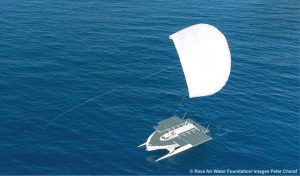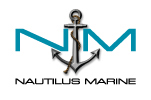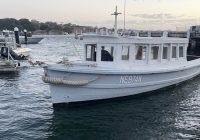Article by METSTRADE
Ships powered by wind force successfully navigate the world and have been doing so for millennia. The re-discovery by the maritime industry that merchant ships can be powered by wind force has invoked new designs for sails and other ways to harvest the power of the wind for propulsion. As a result, wind propulsion for yachts is no longer limited to traditional sail cloth rigs either. Motor yachts save fuel and emissions by applying wind force, too.

Rigid wing sails for yachts: an advanced wind propulsion technology
Availability of electric power without buzzing generators on board increases the luxury experience. Maltese yacht developer ZEN (Zero Emission Nautique) builds their ZEN50, a long range catamaran clad with solar panels that supply electricity for household functions and in-port propulsion. Out on open water, the ZEN50 will sail using its AERO wing sail.
This easy-to-manage, automated rigid sail was developed by the French yacht design and naval architecture studio VPLP. The wing sail has an optimised profile and an adjustable flap along the trailing edge, to adjust camber to control the power in the sail. The AERO wing has been developed to provide merchant vessels with wind propulsion, but proves to be highly successful for yachts, too.
They produce more power per square metre than traditional soft sails. The profile of a wing sail is three dimensional, versus a two dimensional – flat – profile of a piece of sail cloth. The AERO wing sail is controlled from a computer, that can be a portable tablet with clear graphics on a touch screen.
Research by rig developing company Rondal has shown that leaving an upright wing sail on a boat, feathering in the wind, will cause less drag than the mast of a soft sail when the sail is lowered. Wind noise and heeling over of a vessel when it is berthed in a harbour while strong winds blow, will be subsequently less than the traditionally rigged yacht.
Kite sails for yachts: harnessing wind propulsion for high speeds
The sailing world speed record is set by a kite surfer. Handling a kite in the wind by steering it in 8-figures, high in the sky forward of the ship, creates a lot of driving force. Pioneering company Sky Sails applied this principle on the general cargo vessel Beluga in 2005, way before using wind assisted propulsion was gaining ground in commercial shipping. Although the system worked, seafarers were reluctant to use the kite towing the ship.
Today, the advanced system of Sky Sails pulls the research and ocean cleaning yacht MS Porrima over the waves. MS Porrima is a swath yacht, meaning that it floats on two submerged tubes, from which very hydrodynamic shaped struts rise to support the boat hull that completely rises above the water.
This hull type is much less affected by the movement of waves. The hull should be high enough above the water so that the waves will not slam into it. The tubes are under water all of the time and do not roll with the waves. The very slim struts minimise the drag. Most of the drag caused by any ship is inflicted at the surface, where the water and the air meet.
At the moment, MS Porrima is being refitted. All the lessons learnt from sailing with skysails and harvesting electric energy from the solar panels should be put to use in the further optimisation of the energy and wind propulsion. The yacht is set to inspire.
Flettner Rotors for yachts: using the magnus effect for wind-powered propulsionThree cylindrical towers rise above the concept model FY.01 by German design studio 3deluxe. These are Flettner Rotors, round rotating masts that generate lift in wind to power the ship. Directing the force of the wind to create propulsion for the yacht is through the Magnus effect. This physics phenomenon shows how a rotating object in an air stream will create high pressure on one side and low pressure on the other, thus generating lift in the direction of the low pressure. Football (soccer) players use this effect to shoot a ball in a curved line.
Flettner rotors are applied in commercial shipping in growing numbers because they use very limited deck space. The rotors rise 40 meters above the deck of the FY.01 and are constructed in light weight natural fibre composite. The yacht is a catamaran. The double hull arrangement offers much stability at relatively low displacement and the slim hulls cause little drag, minimising the need for horsepower in the engine room. Harbour propulsion and manoeuvring is electric. Electricity is mostly supplied by solar panels on the roof, but the engine room has a hybrid set-up with also diesel powered generators.
Turbosails and ventifoils for cargo and research yachts
The patented wind propulsion system that oceanographer and film maker Jacques Cousteau developed, has only been propelling his own research vessel Alcyone. He called his invention Turbosails. Cylindrical sails are mounted with a flap and have an air inlet grid. The ‘sails’ can be rotated and air is sucked in by a fan to increase the effect of the sails and stir up propulsion power. Similar systems under the name of Ventifoils are installed in increasing numbers on cargo ships. Dutch naval architecture office Econowind specialises in this kind of wind propulsion, claiming to reduce fuel cost by up to 60 per cent.
Yachts with Ventifoils or Turbosails are not known by the editor.
Dyna Rig technology for superyachts: automated multi-mast rigging
In 2005, the late millionaire Tom Perkins wanted to have a sailing yacht that would perform well, boast the astonishing looks of a full rigged ship but not pose all of the difficult and crew demanding handling issues of a traditional square rigged multi masted vessel. He approached rig specialists at GDNP design and they found the original drawing for the Dyna Rig. This German invention from the 1960’s was created to try to cope with the oil crisis that was threatening the economy and shipping by applying wind propulsion without the extensive number of crew needed for sail handling.
Even better than in would have been possible in the 1960’s, the Dyna Rig was automated and the result was the very first Dyna Rigged superyacht Maltese Falcon. The rig has three unstayed, self-supporting rotating masts that carry square sails on curved spars. Rig performance has proven to be remarkably good.
In 2017, eleven years after the launch of Maltese Falcon, the second Dyna Rig yacht was launched named Black Pearl. The sails retract to roll into the mast and can be deployed from the helm station by activating the lines that pull them out of their rolled position inside the mast along the spars to unfold. Masts are hydraulically rotated into the correct angle to place the sails in the wind. The curvature of the spars increases thrust of the sails as compared to traditional square rigged ships.
Inflatable wing sails for yachts: a new prototype for fast and easy wind sailing
Tested, proven to provide easy sail handling and more forward thrust per square meter than conventional sails and even possible to construct using cheap materials, the inflatable wing sail is still in its prototype phase. Inventors Edouard Kessi and Laurent de Kalbermatten from Switzerland developed their inflated wing sail for yachts and tested it on lake Geneva. Their 9 metre long sailing boat proved very light on the helm and sail handling is very gentle.
In 2020, tyre manufacturer Michelin bought the concept to market it for merchant vessels. Michelin named the inflatable rig Wisamo. In its full size of 100 square meters, it was tested aboard the cargo vessel Pelican sailing between Pool, UK and Bilbao, Spain over the Gulf of Biscay in July 2023.
Apart from the prototype on the boat of the inventors and a cabin yacht that Michelin fiited with Wisamo for testing, no yachts up to now are known to have an inflatable wing sail. The sail easily blows up, needs very little pressure to keep its shape and is supported by a simple telescopic mast. This invention has potential of making sailing fast and easy for a wide public.







